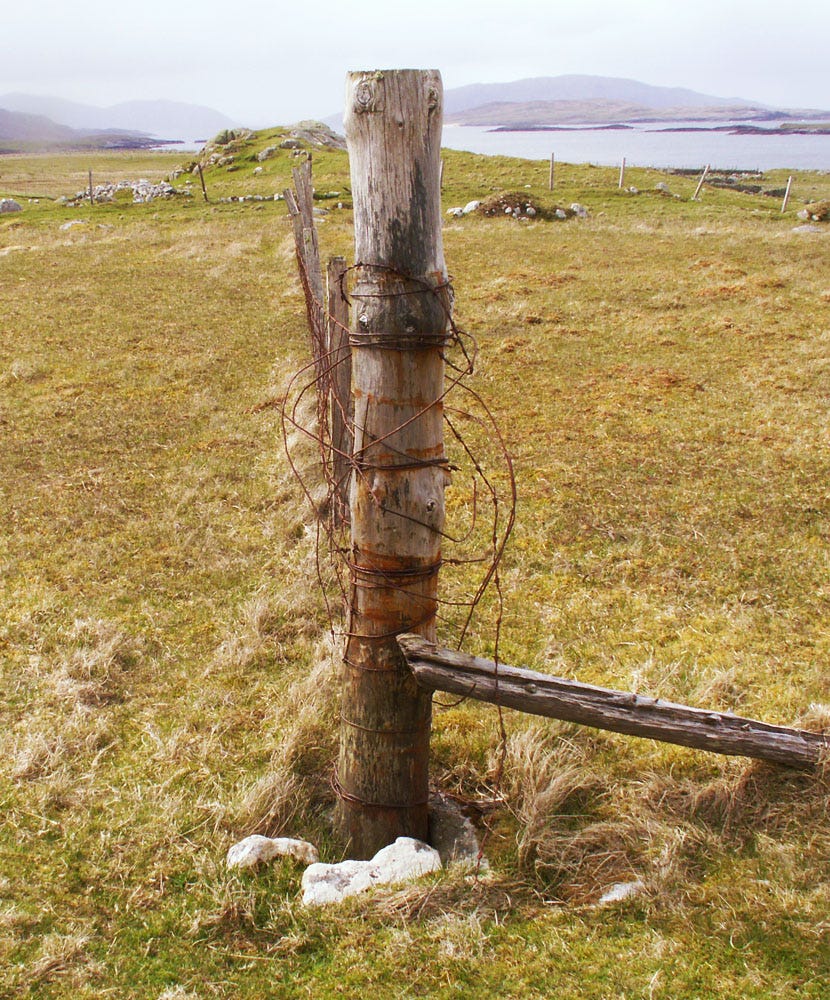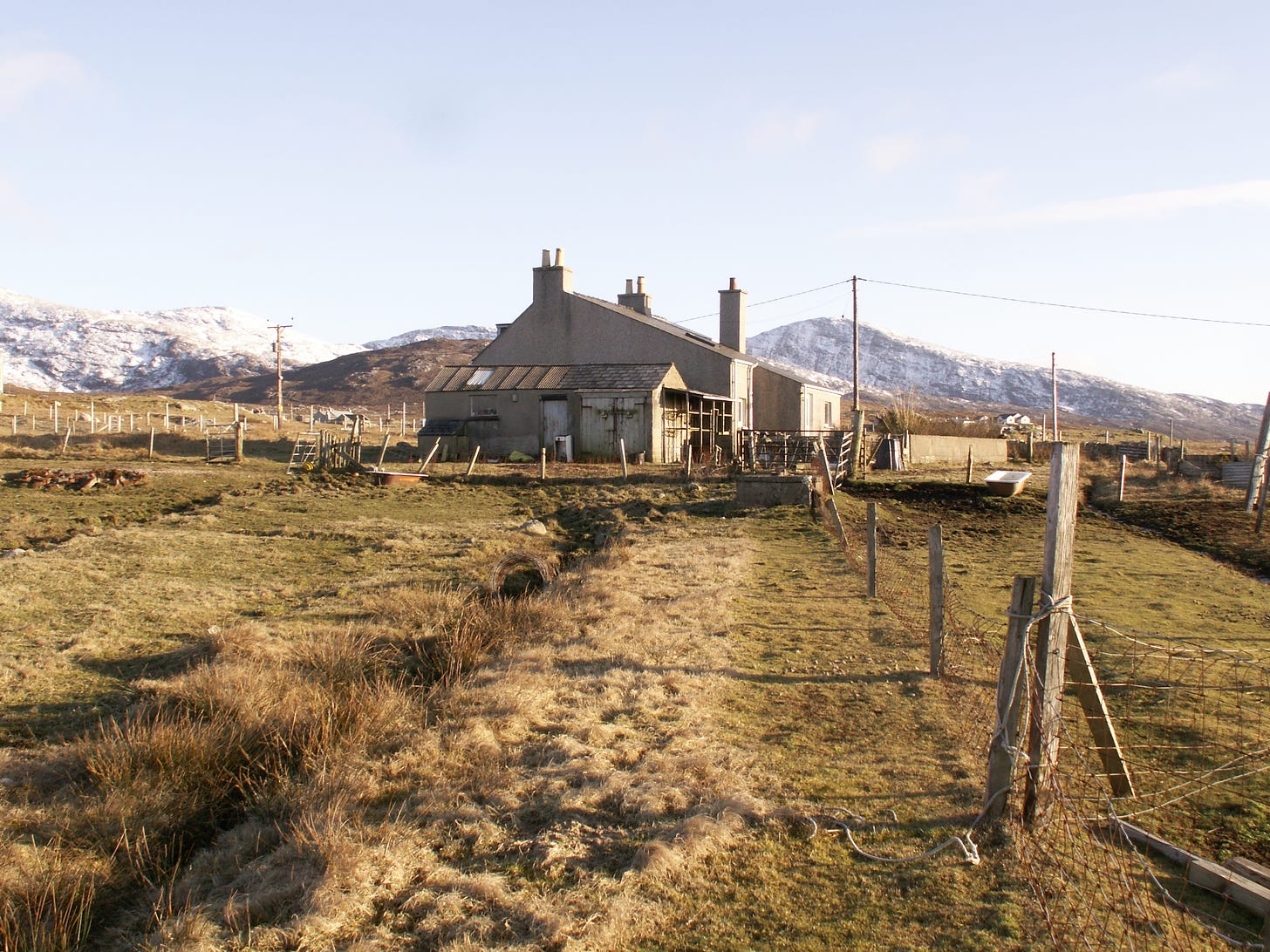‘Riverwitch’ is a collaborative project with my wife Sharon Blackie, writing on her Substack The Art of Enchantment. It’s the re-understanding of a prose duet we wrote for each other back in 2014, both grieving and celebrating our dislocation from the Isle of Lewis in the Outer Hebrides to Donegal in north-west Ireland. It offers a story-within-a-story as, ten years on, we try to make sense of the ways in which places claim us, mark us – and then, when it’s time, cast us loose. We will take turns every Wednesday to revisit one of the original posts and add new reflections and insights. Sharon’s first Riverwitch post, Severance, was last Wednesday. This is my first. You can find more of the background to this project here.
The Field - January 2014
Through the half-light of a northern winter morning, through a smudging rain that wets you from the inside out, through air saturated with the sound of the Atlantic swell, never resting, looms a fenceline. In the midst of a dereliction of fallen stone walls, corroded stumps of posts and needle-sharp rottings of old wire, there is this tight, new stretch of stock fence, the wire still shiny, the posts young and straight-backed, parading up the slope. Feel the tension of the wire. This fence will last fifteen years or so at attention and maybe a further ten at ease, I would guess, with a little fettling here and there, where it crosses the wetter ground.
We stop, the two collie dogs and I, on a rock outside the gate to this shiny new field of two acres. With its boggy west end, the ditches only half-dug, but a good dry east end where it rises up the brae. The dogs have worked it before but this time there are no sheep in it so they look, discount and sit for a while, wondering what’s next. I look and look, as if on a magical quest, standing before the gate which will only open if I ask it the right question. Which is a strange juncture to have reached, sitting on a huge Lewisian gneiss outcrop outside my own field, rebuffed by the fence which I myself built and dug and hammered and strung, carrying every hundredweight of wood and wire and rock by hand, since no track approaches this field down by the shore.
The year before last I fenced this field through spring and summer, stealing four hours here, five there, from other work on the croft. In late summer a short-eared owl took up residence. Just a single bird, I supposed a juvenile, but it was there regularly and I found some feathers and a roost in the thick grass, along with a few pellets. We had plans, the owl and I. The bird was ready to move on, looking to get some better territory down in Uist, where the ground isn’t so bare nor the voles so thin. I said that I was staying put, and look at the strong fence I was making to keep my tups from straying, with a field shelter and running water once I cleared out the main field drain.
The dawn light is firming now, although the sun will still be another hour climbing rocky mountain paths before it reaches the top of the Mealasbhal ridge, three miles or so inland to our east. From where I sit, The Field, still my field for now, a narrow rectangle, a legacy of the origins of croft land, stretches away from me and up the slope as an exercise in perspective, the effect heightened by the regularity of the posts and their fresh pale colour against the wet brown of winter rough grazing. I ask the gate again, in all the languages I know, with all the incantations I have learnt or guessed at, to let me in. But its face remains steady and its eyes fixed on the western horizon.
From the top of the eastern slope of this field a person might look south-south-west and there would be nothing but the Gasker lighthouse and the curvature of the earth between them and Donegal.
Thoughts about The Field – September 2024
Sharon and I lived on and worked a croft on the far south-west coast of Lewis, in the crofting community of Breanish, at the beginning of the twenty-first century. It is important to locate our experience in space and time. Crofting is a chameleon, forever adapting. This is just a glimpse of one place at a particular moment. Your experience may be very different.
If you have not lived in such a place, how should I tell you what a croft is? If I just say the word out loud, even after all these years, its history slams down angrily on the table where I am writing and shakes the house - all ten heavy volumes of it, leather bound. A croft is an experiment in social engineering, a canny tool to enslave a people, a brave attempt to free a people, the foundation of a beautiful way of life and a con trick. A contradiction which wrestles with itself out on the far north-western vanishing fringes of our modern world.
You cannot live off a croft. That is how they were designed. Big enough to hold the heart tethered to the ancestral land. Too small to feed a family. So they kept a workforce in place. The workforce that was once needed for the kelp industry, then for the meat-grinder of the Great War. Lately for the salmon farms which riddle the inlets of the Western Highland coast like a cancer. In the busted intervals between these booms, the people make do and mend. Their crofts are precarious footholds on the towering cliff of history.
But the plans of the great and the powerful do not always play out in the way they envisaged. The deliberate creation of a sub-subsistence economy had unforeseen results. Over the centuries the people of Breanish and the land of their crofts grew into one another like fingers in a glove. The old men of the village, their sons away working in Stornoway, or offshore, would tell me of their childhood. Every house had a cow. A milk cow. And therefore, of course, her succession of calves. The village maintained a single bull, shared with two other smaller settlements along the coast. I once asked who owned the bull. The old man looked perplexed. I’m not sure if he understood the question.
In the dark, cold times of the year the cows were kept overnight in the byres adjoining the houses. In the first glimmers of morning they would be let out, plumes of dragon-fire shooting from their nostrils into the frosty air. Each day of the week a different child would walk through the village before they went to school and the cows, one by one, would step out onto the road after them, exchange their greetings and gossip with the rest of the herd, and be led out to the day pasture on the common grazing. In the evening another child would escort them back through the village. Each beast would bid the company farewell and turn into their own croft.
A biologist with expertise in cold-water coral reefs would instantly recognise this encrusting of the western shore of Lewis. Crofts, biologically speaking, do not actually exist in isolation, could not exist outside of the symbiotic communities in which they are embedded. A crofting community, then, is the fundamental living unit. Are there distinctions to be drawn between the crofters and their neighbours, between the people and the land? Probably. But any such dividing lines would be purely academic. The whole is the functioning assemblage.
Like the marine biologist, I too had seen a phenomenon like this before. Up until a year or so before we moved to Lewis I had served almost two decades as a Tornado pilot on front-line squadrons of the Royal Air Force. Each frosty morning the men and women of the squadron would bring the great docile beasts out of their hardened concrete byres and they would exhale their dragon-fire. The squadron was the living unit and we pilots had our particular part to play in it. We, like the west-coast crofters, depended on each other for our survival.
When Sharon and I agreed to buy the croft we had been in Breanish for a total of one hour. We were impulsive and sure of ourselves back then. We fell in love with places easily, guilelessly. And hell, I was a Tornado pilot. Making snap decisions was a way of life. Sharon, well, you know Sharon. The solicitor who handled the sale, a Lewisman himself, joked that we’d need a roll of blue rope. Breanish, it turned out, had a nickname – the blue-rope village. Every gate was rotted off its hinges and held up with blue rope. Fences had succumbed to the endless blast of salt spray and were tied together with blue rope. That’s fine, we said. I know how to fence and hang a gate.
Thirty-five years before Sharon and I moved in, all but one of the 30 or so crofts in Breanish were in the hands of local families who had lived there for many generations. I know because I had the immaculate handwritten records of the village’s Grazings Committee in my keeping for the roughly two years that I served on it. By the time we got there only about half were still owned by the old families. Of those, most of the younger generation had moved away. At the time, we were spectacularly slow to understand the meaning of this. Although for a while it continued to look as if it were alive, the coral reef was already bleached past the tipping point. We were determined that it should not be so. We were very determined.
The field in this original Riverwitch post was a cypher for all the lessons I learnt in that period where I tried to play King Canute and, being more stubborn that the old king himself, nearly drowned in the process. Our croft had a couple of small fields around the house and another one a few hundred yards away down near the shore. We only ever called it The Field. The rotted fencepost in the picture was at the north-east corner of it. The ownership of that field had been the subject of a long and bitter legal wrangle between two Breanish families during the 1960s. When I arrived it had long since been abandoned. I re-fenced it and dug out the ditches and drains. I hung a shiny new 12ft metal gate at the shore-side entrance. Yes, damn it, I even carried seaweed up from the shore and dug it into the soil. So I took possession of it. Or it took possession of me.
The slow bleaching of a way of life progressed so gradually that you could almost not perceive its advance. Then one morning I noticed that my fingers and cheeks had become deathly white. I had to leave. I brought my fine tup and his companions off the field that I had prepared for him, and took him to a good home. And a shiny new metal gate down by the beautiful shore would never open for me again.






I don’t think the quaver in your voice at the end of this moving chapter was embellishment for the reader was it..? I am gulping back tears David… no, in fact they are flowing freely!
Good grief, the wrench of person from land and animals is so hard to disguise…
As always I am caught by your so perceptively emotional and metaphoric words my friend - just beautiful… and heartbreaking.
As an aspiring writer I am in awe of your ability to paint a feeling and an image in my mind.